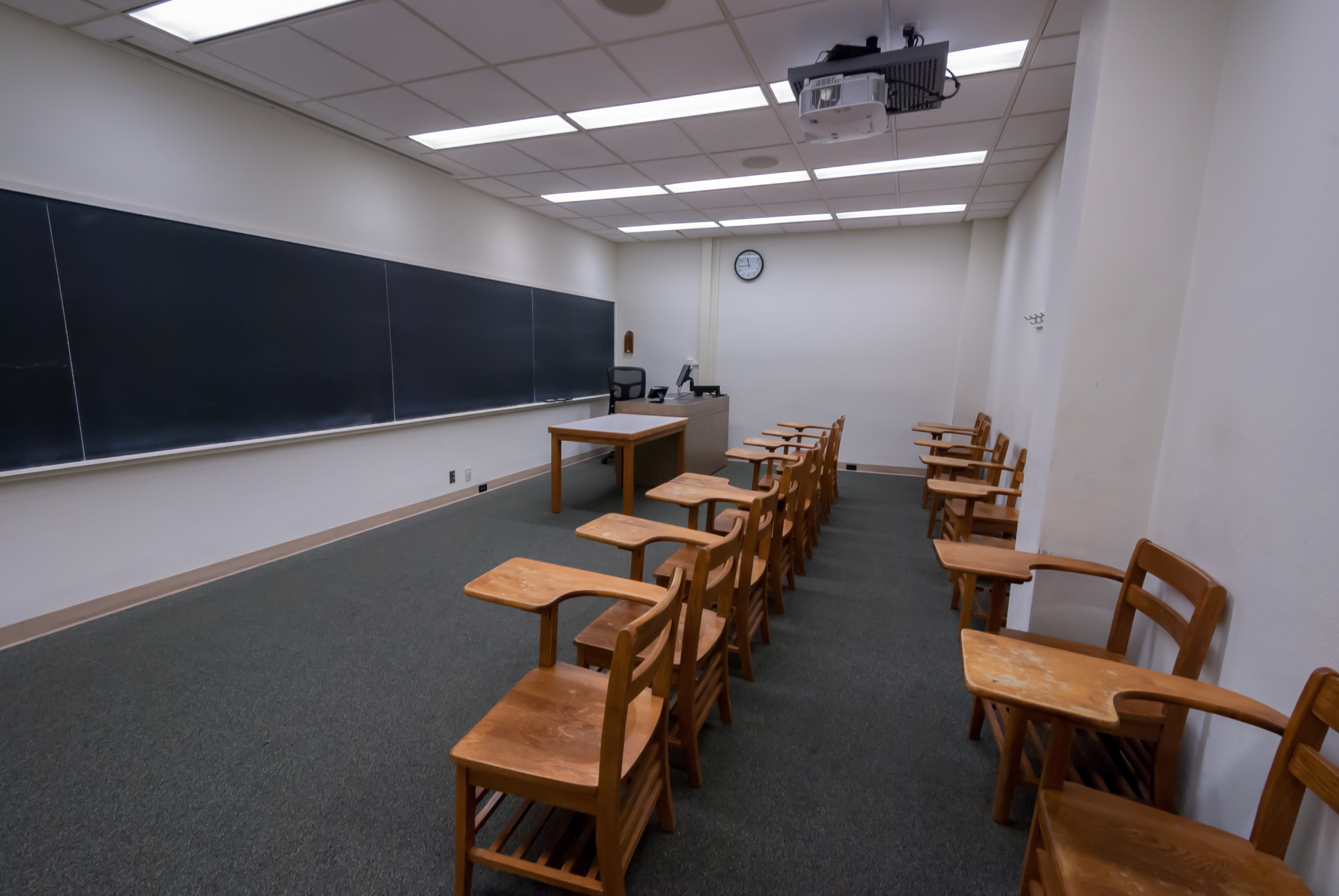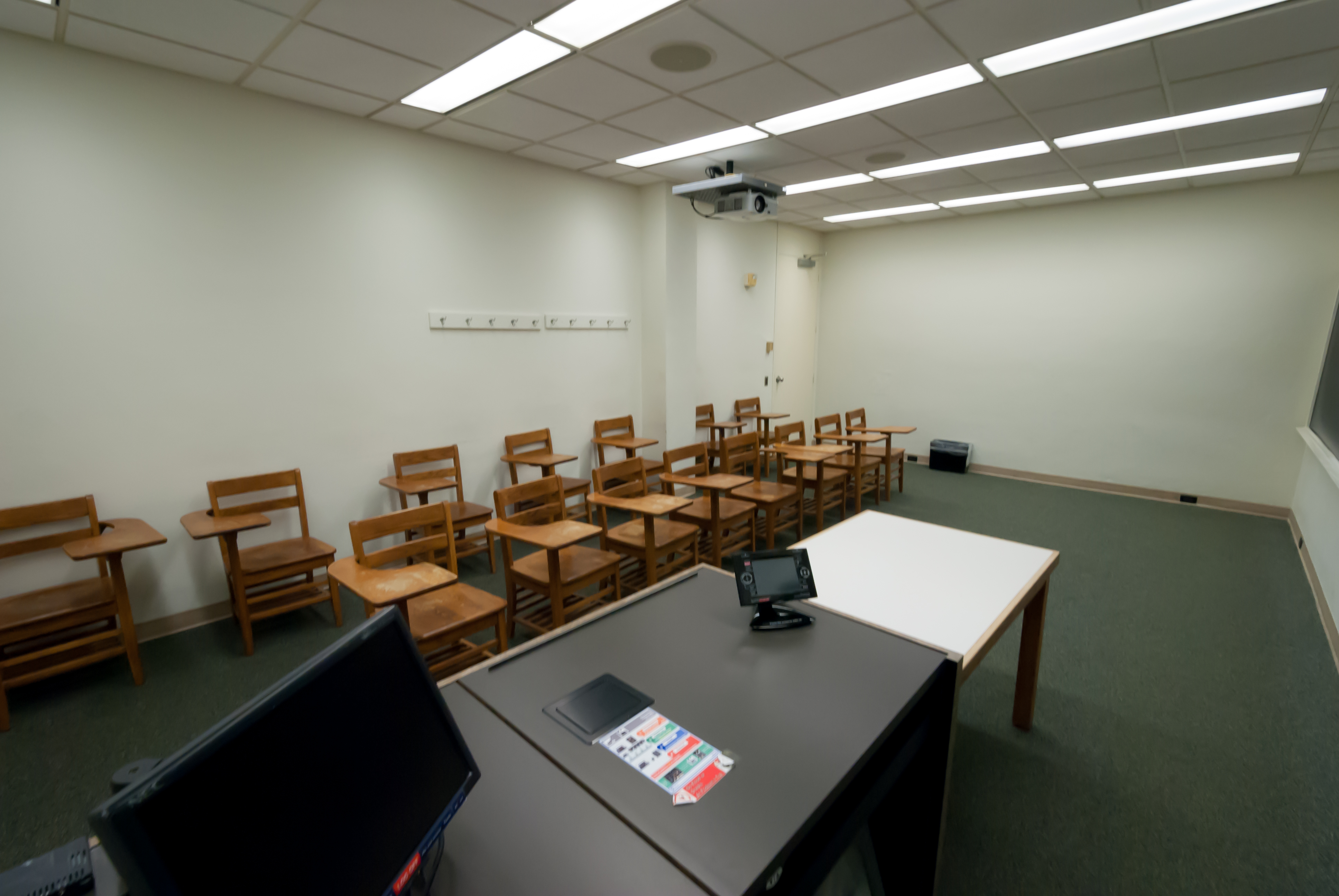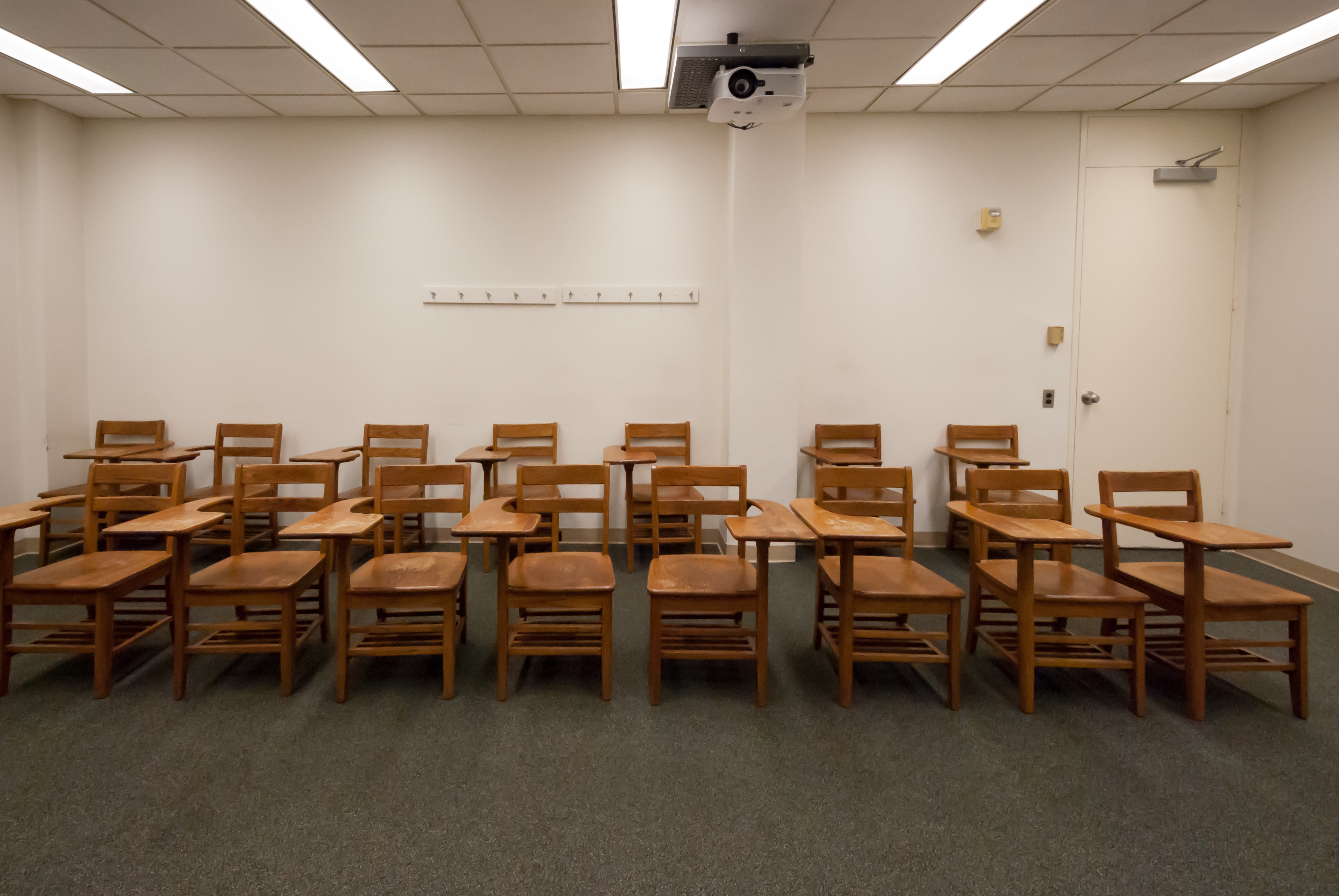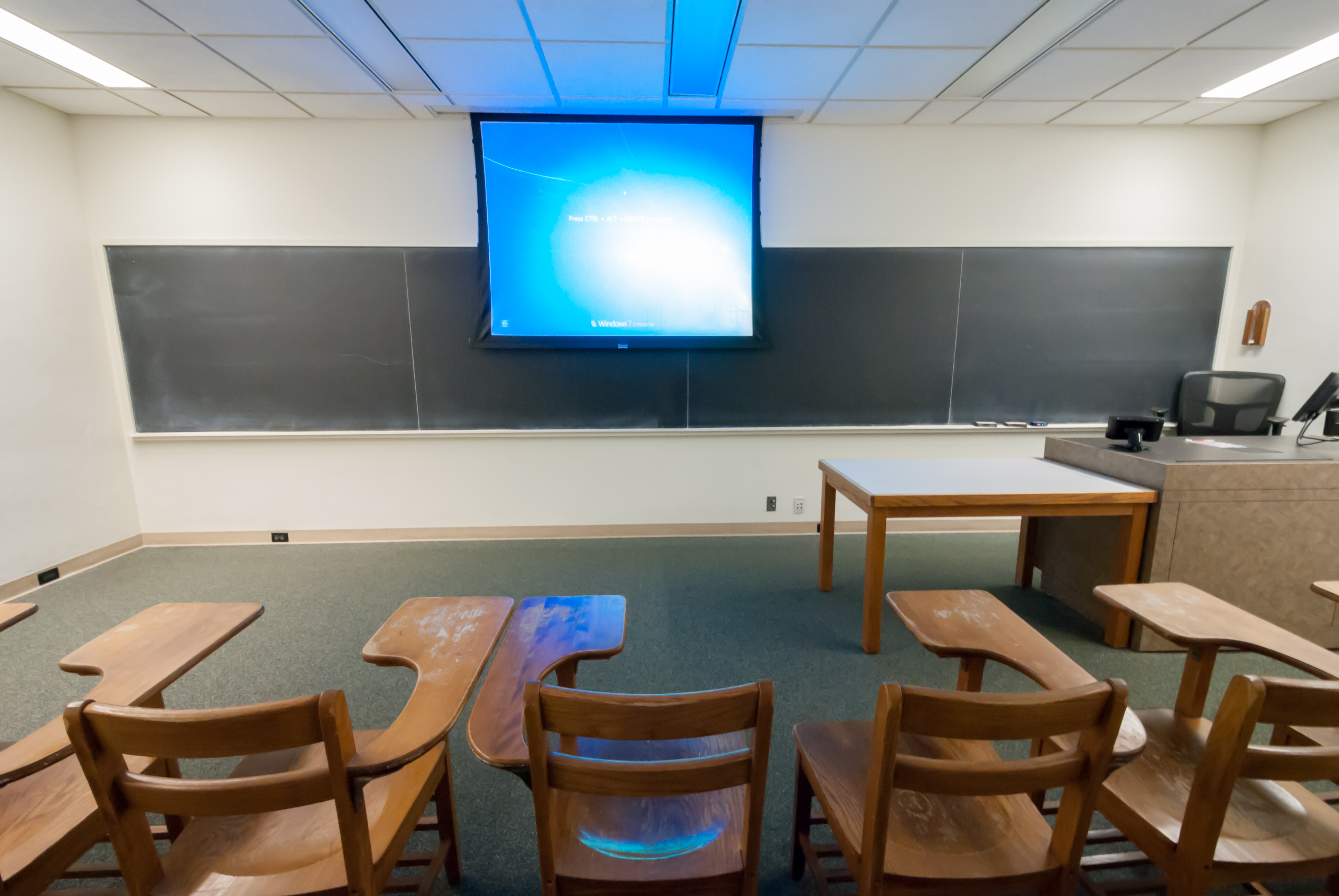HBH 453 Herman Brown Hall
-
Rear View-Projector Off
-
 Entrance View
Entrance View
-
 Instructor View
Instructor View
-
 Front/Center View
Front/Center View
-
 Rear View-Projector On
Rear View-Projector On
- Room Type
- Classroom
- Seats
- 17 - Desks
- Lighting
-
Fluorescent
Zoned
Blackout
- Windows
- No windows
- Writing Surface
-
Chalkboard
24'(W) x 4'(H) - Projection Surface
-
Retractable (motorized)
6'(W) x 4'(H) - Computers
-
Instructor PC
1 PCs
1 Laptop VGA Ports
- Outlets
-
Power at seats? No
- Video Conferencing
-
Available? No
- Accessibility
-
Student Wheelchair Access? Yes
Instructor Wheelchair Access? Yes
- Flooring
-
Carpet
Request this room Request Help
Technology Instructions
Podium 4 - Lite
The "Podium 4 - Lite" class of podium is controlled by a touch-panel remote which is located either on the lift section of the podium surface or on the wall adjacent the podium. The system contains a PC computer only, blu-ray/dvd disc player, and laptop VGA, HDMI, and stereo audio connection inputs.
Classroom activation:
1 - Wake the touch-panel:
With a firm touch to the “touch-panel” screen or a firm press to the top left round button will wake the panel from hibernation. A “welcome image” will appear prompting you to perform another firm touch to the screen in order to continue.
2 - Activation of projector:
With the touch-panel activated, a message box will appear asking whether or not the projector will be used for the session. Press "yes" if affirmative, press "no" if negative.
Note: If subsequent use of the projector is required, pressing the “mode select” hard button on the right side of the touch-panel will activate the previous touch-panel message box, at this time, "yes" can be selected to activate the projector.
3 - Source display:
If “yes” is selected to activate the projector, a guide dialog box will appear prompting the user to select their desired source. Please make sure to select the source you wish to use at this time.
Note: The PC may be in hibernation mode; thus you will have to "wiggle" the mouse or press the "Esc" (escape) button on the keyboard to wake the computer.
4 - Screen control:
The screen will be lowered automatically when the projector activates, thus there is no need to lower the screen manually. However, there is a screen switch on the wall nearest the podium if required.
5 - Monitor:
The monitor should be left on at all times, however “sleep mode” does activate after no source is present for 15 minutes. To wake the monitor, you must first activate the system at the “touch-panel”, wake the computer you plan to use by pressing the escape button or wiggling the mouse. Once the computer is operational an image should be presented on the monitor. It’s possible the monitor was powered off if no image is viewable on the monitor. Please locate the monitor power button and press to activate the monitor (location of power button will vary depending on monitor model).
6 - Audio:
There are three audio levels that must be taken into consideration when operating room audio. The computer audio should be at max level. The software audio should also be adjusted accordingly. The room audio at the touch-panel can then be adjusted up or down to further calibrate the room audio, this can be done using the “up” and “down” hard buttons on the left side of the touch-panel.
Note: If the Mac computer audio is "greyed out", this indicates that the audio can only be adjusted through the touch-panel. This is a function of the mac computer when connected to a source via HDMI cable.
7 - Microphones (if applicable):
Please see the corresponding microphone "tab" for room specific instructions.
Note: Not all classrooms are equipped with microphones.
Issues, questions, or urgent assistance please contact OIT Operations desk at 713-348-4989.
Dell OptiPlex 9020:
Operation:
The PC computer can be selected from the source selection device particular to the system being used. The PC computer has a 15-minute inactivity sleep timer that will activate when the keyboard or mouse are not moved, however the timer is rendered inactive when viewing a powerpoint file in presentation mode or watching a video (youtube, netflix, etc, or media player) in full screen mode. When the PC computer is selected you may need to "wiggle" the mouse or press any key on the keyboard to wake the computer.
Login:
On the login screen you may enter your "netid" or "temporary visitor id" that was obtained through the OIT help desk 713-348-HELP (4357). All software on the PC computer is available to all who login to the computer. The current software suite can be found at the following link.
USB:
The PC computer has USB ports on the front of the computer that can be used to plug and access your USB memory stick, charge a mobile phone, or plug a wireless receiver for a presentation advancing remote.
Software Link:
PC Software Load: (Fall 2016 - Spring 2017)
Issues, questions, or urgent assistance please contact OIT Operations desk at 713-348-4989.
Document Camera (AverVision 300AF HD)
The "document camera" allows the user to display content such as documents, negatives, transparencies, and 3D objects onto the classroom projector, display, or monitor making presentations more accessible to the viewers and giving the instructor a valuable tool for teaching and a replacement for overhead projectors.
1 – Activation:
You must first select “document camera” on the touch-panel, flip-top controller, or button remote before the image can be projected through the classroom system onto the projector and monitor. Once the image is projected you may activate the camera by selecting “on” at the touch-panel, or powering on the camera from the “silver button" on the right side of the camera, opposite the camera arm. To ensure the camera will output video to the projector and monitor you must ensure that the camera is set to “camera” on the document camera control panel located on top of the document camera body; this will be evident due to an active green light on the button.
Note: Images will not pass to the projector and monitor if “playback” or “pc” are selected on the document camera control panel.
2 – Control:
The “document camera” should be controlled by the “touch-panel” on the document camera control dialog. This dialog is present when the “document camera” source is selected. The available controls consist of “on/off”, zoom in/ out, auto adjust focus, freeze image, and in some cases depending on the document camera model, “light on/off”. If the room is not equipped with a touch-panel controller, then the user will have to control the functions of the document camera through the control panel located on the camera body. These controls consist of zoom in/ out, freeze image, auto adjust focus, and other functions that are not necessary for normal classroom usage. Lighting varies depending on the document camera model. If a “light on/off button” exists on the control panel, the lights will be activated by this button, if not, the light will be activated at the camera head and can be turn on/off by a small switch. There are three settings associated with this switch, being, camera light on, camera off, camera off with laser pointer one which denotes the area of projection, and light on with laser pointer on.
Note: If the user would like to be trained to use more advanced functions of the document camera they can contact the OIT operations desk at 713-348-4989 and a technician will be dispatched to assist with training.
Issues, questions, or urgent assistance please contact OIT Operations desk at 713-348-4989.
In this room:
Shure Microphone: (ULX Model)
Shure lavaliere microphone transmitter (ULX-J1) operation instructions.
1 - Activation:
The "power on/off switch" is located at the top of the microphone transmitter. When power is activated the display window will show the group and channel and battery level. Please be sure to pair the correct transmitter with the correct receiver, this can be done by ensuring the group and channel numbers match on both devices.
To use the lavaliere microphone transmitter, take the microphone portion of the transmitter and clip it to the center of the chest, no more than 6 inches from the chin (Making an L shape with the index finger, and placing the index finger underneath the chin, with the thumb on the chest, will give you a near approximate location of where, on the chest, to clip the microphone). This would be the optimal location for the lavaliere microphone to transmit a voice signal, since the center chest location will capture the voice signal regardless of what direction the head is turned.
2 - Deactivation:
To turn "off" the transmitter, flip the "power on/off switch" to the “off” position. The display window lights will then turn off, thus ensuring the microphone has been deactivated.
Note: Please be sure to turn “off” the microphone when not in use, in order to save battery life and not cause issues for the next user.
3 - Muting:
The Shure ULX model microphone transmitter cannot be muted from the body pack and can only be toggled on/off or muted from the main classroom audio controls. The ease in which the microphone transmitter is turned on/off precludes the necessity for a mute function usually found on other microphone transmitter models.
4 - Volume:
You may adjust the volume at the podium volume controls, either through a touch-panel, flip-top button controller, or remote button controller. All microphone audio can be adjusted by the podium audio controls. For more information, please see the "room set-up" page of the room instructions.
Note: Please do not attempt to adjust the gain levels or any other functions on the microphone transmitter, this will adversely affect amplification and operation of the microphone system.
Issues, questions, or urgent assistance please contact OIT Operations desk at 713-348-4989.
Sony Microphone:
Sony lavaliere microphone transmitter (UTX-B03) operation instructions.
1 - Activation:
Press and hold the "power/muting" button for 3 seconds in order to activate the microphone. A green light will appear on the top left of the microphone marked "power".
Positioning: To use the "lav" microphone, take the "lav" microphone portion of the transmitter and clip it to the center of the chest, no more than 6 inches from the chin (Making an L shape with the index finger, and placing the index finger underneath the chin, with the thumb on the chest, will give you a near approximate location of where, on the chest, to clip the microphone). This would be the optimal location for the lav microphone to transmit a voice signal, since the center chest location will capture the voice signal regardless of what direction the head is turned.
2 - Deactivation:
To turn "off" the transmitter, hold the "power/muting" button for 3 seconds. The transmitter will then turn "off".
Note: Please be sure to turn “off” the microphone when not in use, in order to save battery life and not cause issues for the next user.
3 - Muting:
To mute the microphone, while the transmitter is "on", press the "power/muting" button once and the "audio" light on the top right of the transmitter will light "orange" thus confirming that the microphone is now muted. To un-mute, press the "power/muting" button again. The orange "audio" light will then turn off. The microphone is now un-muted.
4 - Volume:
You may adjust the volume at the podium volume controls, either through a touch-panel, flip-top button controller, or remote button controller. All microphone audio can be adjusted by the podium audio controls. For more information, please see the "room set-up" page of the room instructions.
Note: Please do not attempt to adjust the gain levels or any other functions on the microphone transmitter, this will adversely affect amplification and operation of the microphone system.
Issues, questions, or urgent assistance please contact OIT Operations desk at 713-348-4989.
